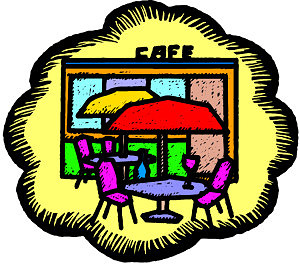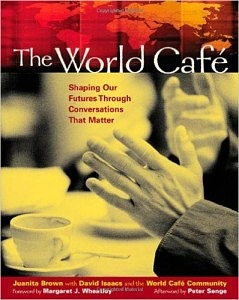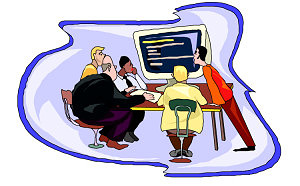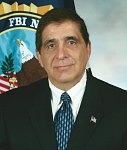“Café Conversations” Contributed by Nick Zingo
 If you want to create meaningful conversations about topic-related issues, in a face-to-face learning environment, veteran law enforcement officer and trainer Nick Zingo has just the thing for you: “Café Conversations.”
If you want to create meaningful conversations about topic-related issues, in a face-to-face learning environment, veteran law enforcement officer and trainer Nick Zingo has just the thing for you: “Café Conversations.”
Nick Zingo served with the Detroit Police Department and the Los Angeles Police Department (LAPD) for over forty years. Then he retired as an LAPD captain and became an instructor for the LAPD Police Reserve Program’s Training Division.
 Nick created a highly successful “Café Conversations” learning activity for the criminal justice classes he currently teaches. As resources for this activity, he used my book “Training from the BACK of the Room“ and Juanita Brown’s book “The World Café: Shaping Our Futures Through Conversations That Matter.”
Nick created a highly successful “Café Conversations” learning activity for the criminal justice classes he currently teaches. As resources for this activity, he used my book “Training from the BACK of the Room“ and Juanita Brown’s book “The World Café: Shaping Our Futures Through Conversations That Matter.”
Nick facilitated the activity numerous times, then wrote a description of the activity in lesson-plan format to share with you and other blog readers. Here is his excellent plan for anyone who teaches, trains, or instructs others. You can use the plan with any topic and any group of adult learners.
Café Conversations
Purpose: To create an understanding of topic-relate issues, to develop ideas, and to seek solutions to topic-related problems by exchanging information with others in an informal learning environment. Café Conversations begins this collaborative, idea-generating process.
Description: Prior to the learning activity, the instructor completely covers each table with easel chart paper, as if the paper were a table cloth. On top of each “table cloth,” the instructor places a packet of specific, topic-related information (handouts/articles) for review and discussion. Each packet covers one topic-related issue or problem to be discussed at that table, as well as related questions to be answered by the participants.
 The instructor also places brightly-colored, broad-tipped markers on each table before the activity begins. And, because the tables are part of a metaphorical “café” – where informal conversations take place in a warm, inviting atmosphere – the instructor may also place a “café-type” article on each table: a small colorful centerpiece, a mug to hold the markers, etc.
The instructor also places brightly-colored, broad-tipped markers on each table before the activity begins. And, because the tables are part of a metaphorical “café” – where informal conversations take place in a warm, inviting atmosphere – the instructor may also place a “café-type” article on each table: a small colorful centerpiece, a mug to hold the markers, etc.
Participants sit at a pre-determined number of tables based on the number of topic-related issues/problems to be discussed. For example, if there are five issues, there will be five groups of no more than five or six participants at each table.
 Table Hosts: Each table group chooses one person to be the “Table Host.” The host remains at the same table for the entire activity. The host is responsible for engaging the participants who are currently seated at the table and makes sure that each person has an opportunity to contribute to the café conversation. The host also makes mental notes of patterns and similarities/differences among the groups. He/she will share these observations later with the whole class.
Table Hosts: Each table group chooses one person to be the “Table Host.” The host remains at the same table for the entire activity. The host is responsible for engaging the participants who are currently seated at the table and makes sure that each person has an opportunity to contribute to the café conversation. The host also makes mental notes of patterns and similarities/differences among the groups. He/she will share these observations later with the whole class.
Group Rotations: Participants begin at the table where they are first sitting. Then they rotate tables with their group. Group rotation depends upon the time allotted for each table’s “café conversation.” Groups rotate to the next table after the pre-determined time limit (the instructor might use an auditory signal to indicate that it’s time to rotate: a noisemaker, music, whistle, chime, etc).
While at each table, the participants review the information in the packet and brainstorm responses to the questions. Then participants use the markers to write their responses on the “table cloth.” There can be as few or as many responses as each group wishes to write.
When the time-limit is reached, the groups rotate to the next table and repeat the process, until all groups have discussed and written their responses to all of the topic-related issues/problems.
Conclusions: After the groups have completed all rotations, each Table Host verbally presents the issues/problems and responses for his/her table to the entire class. The hosts also present their observations: patterns and similarities/differences in groups and in their approaches and responses to the issues.
If time allows, the instructor can hold a final conversation with the entire class, with anyone commenting on the content, the activity, or suggestions for “next steps.” The instructor may also ask for a volunteer to compile the table group issues and responses into a document, which is then shared with all class members.
References:
Bowman, S. L. (2009). Training from the back of the room! 65 ways to step aside and let them learn. San Francisco, CA: Pfeiffer.
Brown, J., & Isaacs, D. (2005). The World Café: Shaping our futures through conversations that matter. San Francisco, CA: Berrett-Koehler.
 More about Nick Zingo: A thirty-year veteran trainer, Nick is currently a Criminal Justice Instructor for the Ventura County Community College District. He recently completed the State of California Peace Officer Standards and Training Master Instructor Certification Course. He holds masters and bachelor degrees as well as a State of California Lifetime Teaching Credential. If you would like to contact Nick (to ask about or discuss his innovative teaching techniques, or just to thank him for this detailed “Café Conversations” blog post), please email him at [email protected].
More about Nick Zingo: A thirty-year veteran trainer, Nick is currently a Criminal Justice Instructor for the Ventura County Community College District. He recently completed the State of California Peace Officer Standards and Training Master Instructor Certification Course. He holds masters and bachelor degrees as well as a State of California Lifetime Teaching Credential. If you would like to contact Nick (to ask about or discuss his innovative teaching techniques, or just to thank him for this detailed “Café Conversations” blog post), please email him at [email protected].

Training Announcement: Two new “Training from the BACK of the Room” Certification Course days have been added to the 2016 Spring train-the-trainer schedule: April 17th 2016 (Orlando, FL) and May 20th (London, UK). Click on WHAT’S NEW or TRAINING EVENTS for more details and links. Anyone who has already taken the 2-day “Training from the BACK of the Room” class may sign up for either Certification Course.
If you haven’t yet attended the 2-day TBR train-the-trainer class, you can access dates and other information below: